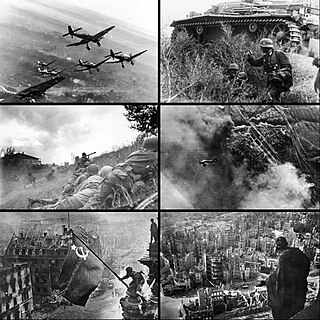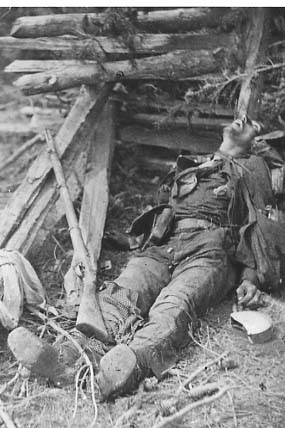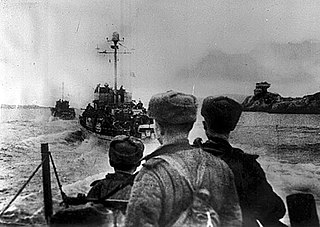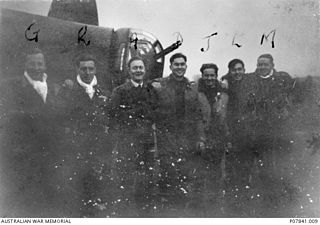
The Battle of Okinawa, codenamed Operation Iceberg, was a major battle of the Pacific War fought on the island of Okinawa by United States Army and United States Marine Corps forces against the Imperial Japanese Army. The initial invasion of Okinawa on 1 April 1945 was the largest amphibious assault in the Pacific Theater of World War II. The Kerama Islands surrounding Okinawa were preemptively captured on 26 March by the 77th Infantry Division. The 82-day battle lasted from 1 April until 22 June 1945. After a long campaign of island hopping, the Allies were planning to use Kadena Air Base on the large island of Okinawa as a base for Operation Downfall, the planned invasion of the Japanese home islands, 340 mi (550 km) away.

The Continuation War, also known as the Second Soviet-Finnish War, was a conflict fought by Finland and Nazi Germany against the Soviet Union during World War II. It began with a Finnish declaration of war and invasion on 25 June 1941 and ended on 19 September 1944 with the Moscow Armistice. The Soviet Union and Finland had previously fought the Winter War from 1939 to 1940, which ended with the Soviet failure to conquer Finland and the Moscow Peace Treaty. Numerous reasons have been proposed for the Finnish decision to invade, with regaining territory lost during the Winter War regarded as the most common. Other justifications for the conflict include Finnish President Risto Ryti's vision of a Greater Finland and Commander-in-Chief Carl Gustaf Emil Mannerheim's desire to annex East Karelia.

The total number of military and civilian casualties in World War I was about 40 million: estimates range from around 15 to 22 million deaths and about 23 million wounded military personnel, ranking it among the deadliest conflicts in human history.
The following is a tabulation of United States military casualties of war.

World War II was the deadliest military conflict in history. An estimated total of 70–85 million people perished, or about 3% of the estimated global population of 2.3 billion in 1940. Deaths directly caused by the war are estimated at 50–56 million, with an additional estimated 19–28 million deaths from war-related disease and famine. Civilian deaths totaled 50–55 million. Military deaths from all causes totaled 21–25 million, including deaths in captivity of about 5 million prisoners of war. More than half of the total number of casualties are accounted for by the dead of the Republic of China and of the Soviet Union. The following tables give a detailed country-by-country count of human losses. Statistics on the number of military wounded are included whenever available.

The European theatre of World War II was one of the two main theatres of combat during World War II. It saw heavy fighting across Europe for almost six years, starting with Germany's invasion of Poland on 1 September 1939 and ending with the Western Allies conquering most of Western Europe, the Soviet Union conquering most of Eastern Europe including the German capital Berlin, and Germany's unconditional surrender on 8 May 1945 although fighting continued elsewhere in Europe until 25 May. On 5 June 1945, the Berlin Declaration proclaiming the unconditional surrender of Germany to the four victorious powers was signed. The Allied powers fought the Axis powers on two major fronts, but there were other fronts varying in scale from the Italian campaign, to the Polish Campaign, as well as in a strategic bombing offensive and in the adjoining Mediterranean and Middle East theatre.

The Western Front was a military theatre of World War II encompassing Denmark, Norway, Luxembourg, Belgium, the Netherlands, the United Kingdom, France, and Germany. The Italian front is considered a separate but related theatre. The Western Front's 1944–1945 phase was officially deemed the European Theater by the United States, whereas Italy fell under the Mediterranean Theater along with North Africa. The Western Front was marked by two phases of large-scale combat operations. The first phase saw the capitulation of Luxembourg, Netherlands, Belgium, and France during May and June 1940 after their defeat in the Low Countries and the northern half of France, and continued into an air war between Germany and Britain that climaxed with the Battle of Britain. The second phase consisted of large-scale ground combat, which began in June 1944 with the Allied landings in Normandy and continued until the defeat of Germany in May 1945 with its invasion.

Throughout the War in Afghanistan, there had been 3,606 coalition deaths in Afghanistan as part of the coalition operations since the invasion in 2001. In this total, the American figure is for deaths "In and Around Afghanistan" which, as defined by the United States Department of Defense, includes some deaths in Pakistan and Uzbekistan and the deaths of 18 CIA operatives.

The casualties of the Napoleonic Wars (1803–1815), direct and indirect, are broken down below:

A casualty, as a term in military usage, is a person in military service, combatant or non-combatant, who becomes unavailable for duty due to any of several circumstances, including death, injury, illness, capture or desertion.

The Petsamo–Kirkenes offensive was a major military offensive during World War II, mounted by the Red Army against the Wehrmacht in 1944 in the Petsamo region, ceded to the Soviet Union by Finland in accordance with the Moscow Armistice, and Norway. The offensive defeated the Wehrmacht's forces in the Arctic, driving them back into Norway, and was called the "Tenth Shock" by Stalin. It later expelled German forces from the northern part of Norway and seized the nickel mines of Petsamo.

Great Patriotic war losses of the Soviet Union were about 27,000,000, both civilian and military from all war-related causes, although exact figures are disputed. A figure of 20 million was considered official during the Soviet era. The post-Soviet government of Russia puts the Soviet war losses at 26.6 million, on the basis of the 1993 study by the Russian Academy of Sciences, including people dying as a result of effects of the war. This includes 8,668,400 military deaths as calculated by the Russian Ministry of Defence.
The article summarizes casualties in different theatres of World War II in Europe and North Africa. Only the military losses and civilian losses directly associated with hostilities are included into the article. The actions of the Axis' and Allied military or civilian authorities that fit the definition of genocide, or war crimes are left beyond the scope of the present article.

During World War II, the Lapland War saw fighting between Finland and Nazi Germany – effectively from September to November 1944 – in Finland's northernmost region, Lapland. Though the Finns and the Germans had been fighting together against the Soviet Union since 1941 during the Continuation War (1941–1944), peace negotiations between the Finnish government and the Allies of World War II had been conducted intermittently during 1943–1944, but no agreement had been reached. The Moscow Armistice, signed on 19 September 1944, demanded that Finland break diplomatic ties with Germany and expel or disarm any German soldiers remaining in Finland.

Statistics for German World War II military casualties are divergent. The wartime military casualty figures compiled by the Oberkommando der Wehrmacht through January 31, 1945 are often cited by military historians in accounts of individual campaigns in the war. A study by German historian Rüdiger Overmans concluded that total German military deaths were much higher than those originally reported by the German High Command, amounting to 5.3 million, including 900,000 men conscripted from outside Germany's 1937 borders, in Austria and in east-central Europe. The German government reported that its records list 4.3 million dead and missing military personnel.
Operation Nordlicht was a German operation during the end of World War II. After Finland had made peace with the USSR, the Germans planned to fall back to defense lines built and equipped in advance across Finnish Lapland. During the operation, the Oberkommando der Wehrmacht gave an order to move from Operation Birke to Operation Nordlicht on 4 October 1944. That meant that instead of evacuating everything and then fortifying on the strong defensive positions, the German 20th Mountain Army was to retreat according to a set timetable to a new defense line in Lyngen, Norway. The Germans retreated using scorched-earth tactics and destroyed almost all buildings and all boats in Finnmark, thus denying the enemy any facilities in the area. The same tactics had already been used in Finnish Lapland. The retreat ended on 20 January 1945. A detailed account of 'the Nazis' scorched earth campaign in Norway' by Vincent Hunt includes statements by eyewitnesses, photographs taken at the time and a map of locations and prisoner of war camps.
In many legal jurisdictions, the manner of death is a determination, typically made by the coroner, medical examiner, police, or similar officials, and recorded as a vital statistic. Within the United States and the United Kingdom, a distinction is made between the cause of death, which is a specific disease or injury, versus manner of death, which is primarily a legal determination versus the mechanism of death which does not explain why the person died or the underlying cause of death and can include cardiac arrest or exsanguination. Different categories are used in different jurisdictions, but manner of death determinations include everything from very broad categories like "natural" and "homicide" to specific manners like "traffic accident" or "gunshot wound". In some cases an autopsy is performed, either due to general legal requirements, because the medical cause of death is uncertain, upon the request of family members or guardians, or because the circumstances of death were suspicious.

More than 2.8 million German soldiers surrendered on the Western Front between D-Day and the end of April 1945; 1.3 million between D-Day and March 31, 1945; and 1.5 million of them in the month of April. From early March, these surrenders seriously weakened the Wehrmacht in the West, and made further surrenders more likely, thus having a snowballing effect. On March 27, Dwight D. Eisenhower declared at a press conference that the enemy were a whipped army. In March, the daily rate of POWs taken on the Western Front was 10,000; in the first 14 days of April it rose to 39,000, and in the last 16 days the average peaked at 59,000 soldiers captured each day. The number of prisoners taken in the West in March and April was over 1,800,000, more than double the 800,000 German soldiers who surrendered to the Russians in the last three or four months of the war. One reason for this huge difference, possibly the most important, was that German forces facing the Red Army tended to fight to the end for fear of Soviet captivity whereas German forces facing the Western Allies tended to surrender without putting up much if any resistance. Accordingly, the number of Germans killed and wounded was much higher in the East than in the West.

Missing Research and Enquiry Service, was a post-Second World War Royal Air Force secretariat that looked into those service personnel in the RAF who were listed as missing in action during operations in the Second World War. The MRES was part of the Air Ministry's Casualty Branch, and was initially set up in 1944, with a dedicated branch established in 1945. It covered many areas of Europe and North Africa, before being disestablished in 1949.














